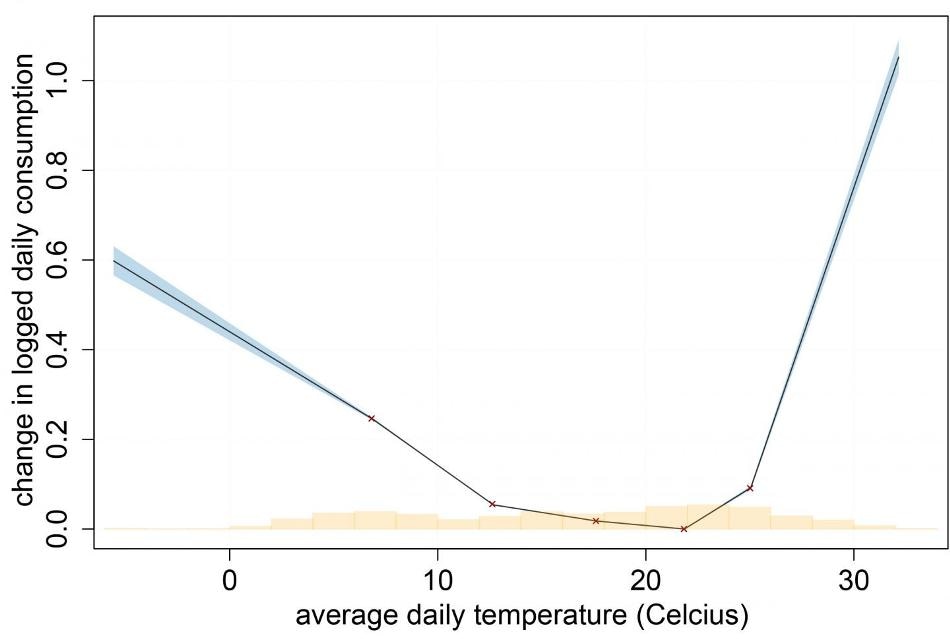Dec 26 2018
An innovative study by Duke University and Fudan University in China has been the first to predict the increase in Chinese residential electricity consumption as a result of climate change. It is a considerable amount.
 A chart from the paper shows how residential electrical use sharply spikes upward once the temperature reaches about 23 °C (73 °F). (Image credit: Duke University)
A chart from the paper shows how residential electrical use sharply spikes upward once the temperature reaches about 23 °C (73 °F). (Image credit: Duke University)
Toward the end of the 21st century, the average increase in Chinese residential electricity use will be around 9% with each degree Celsius increase in the global mean surface temperature (GMST).
There will be a 36% increase in the peak electricity use for each degree Celsius increase.
Researchers have predicted that by 2099, the mean surface temperature will be 2–5 °C hotter than it is at present. If the consumption patterns stay the same as the current scenario, there would be an 18% increase in the average residential electricity demand in China on the lower side and nearly 55% on the higher side. At the minimum, there would be a 72% increase in peak usage.
This study outcome has significant implications for energy grid planning; however, even in the absence of climate change, it is estimated that the average household electricity consumption in China would double by 2040 as a result of increasing incomes.
The study titled “Climate Change and Residential Electricity Consumption in the Yangtze River Delta, China,” carried out by Yating Li, William A. Pizer, and Libo Wu, has been described in the Proceedings of the National Academy of Sciences in the week of December 24th, 2018.
Our findings contribute solid evidence supporting China’s low-carbon policy by showing how important increasing demand from the residential sector will be.
Libo Wu, Professor and Director, Center for Energy Economics and Strategies Studies, Fudan University.
The researchers investigated the way customers responded to changes in daily temperature by analyzing data from over 800,000 residential customers in the Pudong district of Shanghai from 2014 to 2016. They merged these data related to consumer behavior with a range of detailed climate model simulations to develop the connection between predicted mean global temperature change at the end of the century and localized projected impacts in China.
“This state-of-the-art approach has been applied to communities in the United States, but this is the first application in China,” stated Billy Pizer, a professor in Duke’s Sanford School of Public Policy and Duke Kunshan University in Jiangsu Province, China. A majority of the earlier studies of these effects have been performed in Western countries.
Despite the fact that residential usage accounts for only one-fourth of total electricity consumption in Shanghai, the focus of scientists was on homes since they are highly responsive to fluctuations in temperature. When it is extremely hot (around August 1) and extremely cold (around February 1), there is a more drastic increase in residential electricity usage in response to temperatures compared to industrial or commercial usage, and this drives peak consumption at such times.
The researchers found that when the temperatures were above 25 °C (77 °F), there was a sharp increase in residential everyday electricity consumption—14.5% for every 1 °C increase in everyday temperature. For instance, compared with a comfortable 20 °C day, when electricity consumption is on the lowest end, a day on which the temperature was 32 °C led to a 174% increase in everyday electricity consumption.
In the comfortable range from 13 °C to 25 °C (55–77 °F), variation in temperature did not trigger residents to adjust their thermostats. When there was a dip in temperatures below 13 °C, there was an increase in electricity use with each 1 °C drop, yet more moderately.
According to the study, Chinese citizens whose income was high used more electricity during the winter. Yet, in Shanghai, the reaction to hot summer days was more or less the same for all income groups—everyone opted for air conditioning.
If we consider that more provinces would become ‘Shanghai’ as incomes rise, our results may ultimately be more broadly applicable.
Yating Li, PhD Candidate in Environmental Policy, Duke University.
The researchers consider that the study outcomes are applicable to other urban areas in the Yangtze River Delta, with similar economic and climate conditions. This metropolitan region includes Jiangsu, Zhejiang, and Anhui provinces, approximately one-fifth of China’s urban population, and one-fourth of the economic output of China (GDP).
The National 863 High Technology Research and Development Program of China (2015AA050203) supported the study. Li is supported by the Duke University Energy Initiative through the Energy Doctoral Student Fellow program.